SkPaint
=======
*color, stroke, font, effects*
- [SkXfermode](#SkXfermode) - transfer modes
- [ShShader](#ShShader) - gradients and patterns
- [SkMaskFilter](#SkMaskFilter) - modifications to the alpha mask
- [SkColorFilter](#SkColorFilter) - modify the source color before applying the
- [SkPathEffect](#SkPathEffect) - modify to the geometry before it
generates an alpha mask.
Anytime you draw something in Skia, and want to specify what color it
is, or how it blends with the background, or what style or font to
draw it in, you specify those attributes in a paint.
Unlike `SkCanvas`, paints do not maintain an internal stack of state
(i.e. there is no save/restore on a paint). However, paints are
relatively light-weight, so the client may create and maintain any
number of paint objects, each set up for a particular use. Factoring
all of these color and stylistic attributes out of the canvas state,
and into (multiple) paint objects, allows canvas' save/restore to be
that much more efficient, as all they have to do is maintain the stack
of matrix and clip settings.
void draw(SkCanvas* canvas) {
canvas->clear(SK_ColorWHITE);
SkPaint paint1, paint2, paint3;
paint1.setTextSize(64.0f);
paint1.setAntiAlias(true);
paint1.setColor(SkColorSetRGB(255, 0, 0));
paint1.setStyle(SkPaint::kFill_Style);
paint2.setTextSize(64.f);
paint2.setAntiAlias(true);
paint2.setColor(SkColorSetRGB(0, 136, 0));
paint2.setStyle(SkPaint::kStroke_Style);
paint2.setStrokeWidth(SkIntToScalar(3));
paint3.setTextSize(64.0f);
paint3.setAntiAlias(true);
paint3.setColor(SkColorSetRGB(136, 136, 136));
paint3.setTextScaleX(SkFloatToScalar(1.5f));
const char text[] = "Skia!";
canvas->drawText(text, strlen(text), 20.0f, 64.0f, paint1);
canvas->drawText(text, strlen(text), 20.0f, 144.0f, paint2);
canvas->drawText(text, strlen(text), 20.0f, 224.0f, paint3);
}
 This shows three different paints, each set up to draw in a different
style. Now the caller can intermix these paints freely, either using
them as is, or modifying them as the drawing proceeds.
SkPaint paint1, paint2, paint3;
paint2.setStyle(SkPaint::kStroke_Style);
paint2.setStrokeWidth(3);
paint3.setAntiAlias(true);
paint3.setColor(SK_ColorRED);
paint3.setTextSize(80);
canvas->drawRect(SkRect::MakeXYWH(10,10,60,20), paint1);
canvas->drawRect(SkRect::MakeXYWH(80,10,60,20), paint2);
paint2.setStrokeWidth(SkIntToScalar(5));
canvas->drawOval(SkRect::MakeXYWH(150,10,60,20), paint2);
canvas->drawText("SKIA", 4, 20, 120, paint3);
paint3.setColor(SK_ColorBLUE);
canvas->drawText("SKIA", 4, 20, 220, paint3);
This shows three different paints, each set up to draw in a different
style. Now the caller can intermix these paints freely, either using
them as is, or modifying them as the drawing proceeds.
SkPaint paint1, paint2, paint3;
paint2.setStyle(SkPaint::kStroke_Style);
paint2.setStrokeWidth(3);
paint3.setAntiAlias(true);
paint3.setColor(SK_ColorRED);
paint3.setTextSize(80);
canvas->drawRect(SkRect::MakeXYWH(10,10,60,20), paint1);
canvas->drawRect(SkRect::MakeXYWH(80,10,60,20), paint2);
paint2.setStrokeWidth(SkIntToScalar(5));
canvas->drawOval(SkRect::MakeXYWH(150,10,60,20), paint2);
canvas->drawText("SKIA", 4, 20, 120, paint3);
paint3.setColor(SK_ColorBLUE);
canvas->drawText("SKIA", 4, 20, 220, paint3);
 Beyond simple attributes such as color, strokes, and text values,
paints support effects. These are subclasses of different aspects of
the drawing pipeline, that when referenced by a paint (each of them is
reference-counted), are called to override some part of the drawing
pipeline.
For example, to draw using a gradient instead of a single color,
assign a SkShader to the paint.
void draw(SkCanvas* canvas) {
SkPoint points[2] = {
SkPoint::Make(0.0f, 0.0f),
SkPoint::Make(256.0f, 256.0f)
};
SkColor colors[2] = {SK_ColorBLUE, SK_ColorYELLOW};
SkPaint paint;
paint.setShader(SkGradientShader::MakeLinear(
points, colors, nullptr, 2,
SkShader::kClamp_TileMode, 0, nullptr));
canvas->drawPaint(paint);
}
Beyond simple attributes such as color, strokes, and text values,
paints support effects. These are subclasses of different aspects of
the drawing pipeline, that when referenced by a paint (each of them is
reference-counted), are called to override some part of the drawing
pipeline.
For example, to draw using a gradient instead of a single color,
assign a SkShader to the paint.
void draw(SkCanvas* canvas) {
SkPoint points[2] = {
SkPoint::Make(0.0f, 0.0f),
SkPoint::Make(256.0f, 256.0f)
};
SkColor colors[2] = {SK_ColorBLUE, SK_ColorYELLOW};
SkPaint paint;
paint.setShader(SkGradientShader::MakeLinear(
points, colors, nullptr, 2,
SkShader::kClamp_TileMode, 0, nullptr));
canvas->drawPaint(paint);
}
 Now, anything drawn with that paint will be drawn with the gradient
specified in the call to `MakeLinear()`. The shader object that is
returned is reference-counted. Whenever any effects object, like a
shader, is assigned to a paint, its reference-count is increased by
the paint. To balance this, the caller in the above example calls
`unref()` on the shader once it has assigned it to the paint. Now the
paint is the only "owner" of that shader, and it will automatically
call `unref()` on the shader when either the paint goes out of scope, or
if another shader (or null) is assigned to it.
There are 6 types of effects that can be assigned to a paint:
* **SkPathEffect** - modifications to the geometry (path) before it
generates an alpha mask (e.g. dashing)
* **SkRasterizer** - composing custom mask layers (e.g. shadows)
* **SkMaskFilter** - modifications to the alpha mask before it is
colorized and drawn (e.g. blur, emboss)
* **SkShader** - e.g. gradients (linear, radial, sweep), bitmap patterns
(clamp, repeat, mirror)
* **SkColorFilter** - modify the source color(s) before applying the
xfermode (e.g. color matrix)
* **SkXfermode** - e.g. porter-duff transfermodes, blend modes
Paints also hold a reference to a SkTypeface. The typeface represents
a specific font style, to be used for measuring and drawing
text. Speaking of which, paints are used not only for drawing text,
but also for measuring it.
paint.measureText(...);
paint.getTextBounds(...);
paint.textToGlyphs(...);
paint.getFontMetrics(...);
SkXfermode
----------
The following example demonstrates all of the Skia's standard transfer
modes. In this example the source is a solid magenta color with a
horizontal alpha gradient and the destination is a solid cyan color
with a vertical alpha gradient.
void draw(SkCanvas* canvas) {
SkXfermode::Mode modes[] = {
SkXfermode::kClear_Mode,
SkXfermode::kSrc_Mode,
SkXfermode::kDst_Mode,
SkXfermode::kSrcOver_Mode,
SkXfermode::kDstOver_Mode,
SkXfermode::kSrcIn_Mode,
SkXfermode::kDstIn_Mode,
SkXfermode::kSrcOut_Mode,
SkXfermode::kDstOut_Mode,
SkXfermode::kSrcATop_Mode,
SkXfermode::kDstATop_Mode,
SkXfermode::kXor_Mode,
SkXfermode::kPlus_Mode,
SkXfermode::kModulate_Mode,
SkXfermode::kScreen_Mode,
SkXfermode::kOverlay_Mode,
SkXfermode::kDarken_Mode,
SkXfermode::kLighten_Mode,
SkXfermode::kColorDodge_Mode,
SkXfermode::kColorBurn_Mode,
SkXfermode::kHardLight_Mode,
SkXfermode::kSoftLight_Mode,
SkXfermode::kDifference_Mode,
SkXfermode::kExclusion_Mode,
SkXfermode::kMultiply_Mode,
SkXfermode::kHue_Mode,
SkXfermode::kSaturation_Mode,
SkXfermode::kColor_Mode,
SkXfermode::kLuminosity_Mode,
};
SkRect rect = SkRect::MakeWH(64.0f, 64.0f);
SkPaint text, stroke, src, dst;
stroke.setStyle(SkPaint::kStroke_Style);
text.setTextSize(24.0f);
text.setAntiAlias(true);
SkPoint srcPoints[2] = {
SkPoint::Make(0.0f, 0.0f),
SkPoint::Make(64.0f, 0.0f)
};
SkColor srcColors[2] = {
SK_ColorMAGENTA & 0x00FFFFFF,
SK_ColorMAGENTA};
src.setShader(SkGradientShader::MakeLinear(
srcPoints, srcColors, nullptr, 2,
SkShader::kClamp_TileMode, 0, nullptr));
SkPoint dstPoints[2] = {
SkPoint::Make(0.0f, 0.0f),
SkPoint::Make(0.0f, 64.0f)
};
SkColor dstColors[2] = {
SK_ColorCYAN & 0x00FFFFFF,
SK_ColorCYAN};
dst.setShader(SkGradientShader::MakeLinear(
dstPoints, dstColors, nullptr, 2,
SkShader::kClamp_TileMode, 0, nullptr));
canvas->clear(SK_ColorWHITE);
size_t N = sizeof(modes) / sizeof(modes[0]);
size_t K = (N - 1) / 3 + 1;
SkASSERT(K * 64 == 640); // tall enough
for (size_t i = 0; i < N; ++i) {
SkAutoCanvasRestore autoCanvasRestore(canvas, true);
canvas->translate(192.0f * (i / K), 64.0f * (i % K));
const char* desc = SkXfermode::ModeName(modes[i]);
canvas->drawText(desc, strlen(desc), 68.0f, 30.0f, text);
canvas->clipRect(SkRect::MakeWH(64.0f, 64.0f));
canvas->drawColor(SK_ColorLTGRAY);
(void)canvas->saveLayer(nullptr, nullptr);
canvas->clear(SK_ColorTRANSPARENT);
canvas->drawPaint(dst);
src.setXfermodeMode(modes[i]);
canvas->drawPaint(src);
canvas->drawRect(rect, stroke);
}
}
Now, anything drawn with that paint will be drawn with the gradient
specified in the call to `MakeLinear()`. The shader object that is
returned is reference-counted. Whenever any effects object, like a
shader, is assigned to a paint, its reference-count is increased by
the paint. To balance this, the caller in the above example calls
`unref()` on the shader once it has assigned it to the paint. Now the
paint is the only "owner" of that shader, and it will automatically
call `unref()` on the shader when either the paint goes out of scope, or
if another shader (or null) is assigned to it.
There are 6 types of effects that can be assigned to a paint:
* **SkPathEffect** - modifications to the geometry (path) before it
generates an alpha mask (e.g. dashing)
* **SkRasterizer** - composing custom mask layers (e.g. shadows)
* **SkMaskFilter** - modifications to the alpha mask before it is
colorized and drawn (e.g. blur, emboss)
* **SkShader** - e.g. gradients (linear, radial, sweep), bitmap patterns
(clamp, repeat, mirror)
* **SkColorFilter** - modify the source color(s) before applying the
xfermode (e.g. color matrix)
* **SkXfermode** - e.g. porter-duff transfermodes, blend modes
Paints also hold a reference to a SkTypeface. The typeface represents
a specific font style, to be used for measuring and drawing
text. Speaking of which, paints are used not only for drawing text,
but also for measuring it.
paint.measureText(...);
paint.getTextBounds(...);
paint.textToGlyphs(...);
paint.getFontMetrics(...);
SkXfermode
----------
The following example demonstrates all of the Skia's standard transfer
modes. In this example the source is a solid magenta color with a
horizontal alpha gradient and the destination is a solid cyan color
with a vertical alpha gradient.
void draw(SkCanvas* canvas) {
SkXfermode::Mode modes[] = {
SkXfermode::kClear_Mode,
SkXfermode::kSrc_Mode,
SkXfermode::kDst_Mode,
SkXfermode::kSrcOver_Mode,
SkXfermode::kDstOver_Mode,
SkXfermode::kSrcIn_Mode,
SkXfermode::kDstIn_Mode,
SkXfermode::kSrcOut_Mode,
SkXfermode::kDstOut_Mode,
SkXfermode::kSrcATop_Mode,
SkXfermode::kDstATop_Mode,
SkXfermode::kXor_Mode,
SkXfermode::kPlus_Mode,
SkXfermode::kModulate_Mode,
SkXfermode::kScreen_Mode,
SkXfermode::kOverlay_Mode,
SkXfermode::kDarken_Mode,
SkXfermode::kLighten_Mode,
SkXfermode::kColorDodge_Mode,
SkXfermode::kColorBurn_Mode,
SkXfermode::kHardLight_Mode,
SkXfermode::kSoftLight_Mode,
SkXfermode::kDifference_Mode,
SkXfermode::kExclusion_Mode,
SkXfermode::kMultiply_Mode,
SkXfermode::kHue_Mode,
SkXfermode::kSaturation_Mode,
SkXfermode::kColor_Mode,
SkXfermode::kLuminosity_Mode,
};
SkRect rect = SkRect::MakeWH(64.0f, 64.0f);
SkPaint text, stroke, src, dst;
stroke.setStyle(SkPaint::kStroke_Style);
text.setTextSize(24.0f);
text.setAntiAlias(true);
SkPoint srcPoints[2] = {
SkPoint::Make(0.0f, 0.0f),
SkPoint::Make(64.0f, 0.0f)
};
SkColor srcColors[2] = {
SK_ColorMAGENTA & 0x00FFFFFF,
SK_ColorMAGENTA};
src.setShader(SkGradientShader::MakeLinear(
srcPoints, srcColors, nullptr, 2,
SkShader::kClamp_TileMode, 0, nullptr));
SkPoint dstPoints[2] = {
SkPoint::Make(0.0f, 0.0f),
SkPoint::Make(0.0f, 64.0f)
};
SkColor dstColors[2] = {
SK_ColorCYAN & 0x00FFFFFF,
SK_ColorCYAN};
dst.setShader(SkGradientShader::MakeLinear(
dstPoints, dstColors, nullptr, 2,
SkShader::kClamp_TileMode, 0, nullptr));
canvas->clear(SK_ColorWHITE);
size_t N = sizeof(modes) / sizeof(modes[0]);
size_t K = (N - 1) / 3 + 1;
SkASSERT(K * 64 == 640); // tall enough
for (size_t i = 0; i < N; ++i) {
SkAutoCanvasRestore autoCanvasRestore(canvas, true);
canvas->translate(192.0f * (i / K), 64.0f * (i % K));
const char* desc = SkXfermode::ModeName(modes[i]);
canvas->drawText(desc, strlen(desc), 68.0f, 30.0f, text);
canvas->clipRect(SkRect::MakeWH(64.0f, 64.0f));
canvas->drawColor(SK_ColorLTGRAY);
(void)canvas->saveLayer(nullptr, nullptr);
canvas->clear(SK_ColorTRANSPARENT);
canvas->drawPaint(dst);
src.setXfermodeMode(modes[i]);
canvas->drawPaint(src);
canvas->drawRect(rect, stroke);
}
}
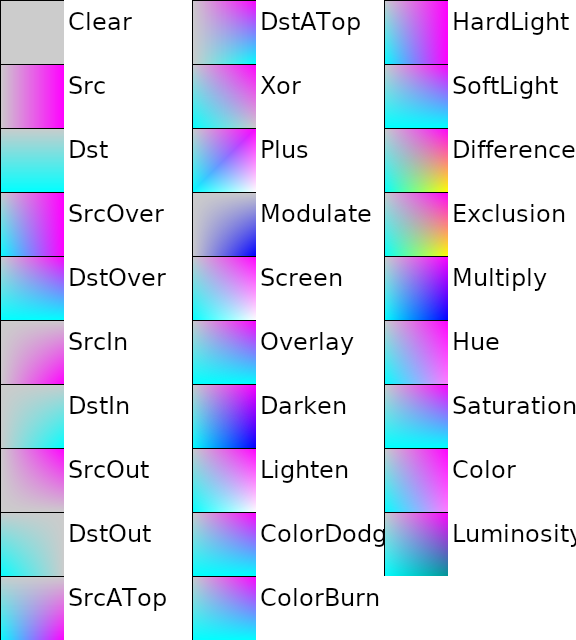 ShShader
--------
Several shaders are defined (besides the linear gradient already mentioned):
* Bitmap Shader
canvas->clear(SK_ColorWHITE);
SkMatrix matrix;
matrix.setScale(0.75f, 0.75f);
matrix.preRotate(30.0f);
SkPaint paint;
paint.setShader(SkShader::MakeBitmapShader(source,
SkShader::kRepeat_TileMode,
SkShader::kRepeat_TileMode,
&matrix));
canvas->drawPaint(paint);
ShShader
--------
Several shaders are defined (besides the linear gradient already mentioned):
* Bitmap Shader
canvas->clear(SK_ColorWHITE);
SkMatrix matrix;
matrix.setScale(0.75f, 0.75f);
matrix.preRotate(30.0f);
SkPaint paint;
paint.setShader(SkShader::MakeBitmapShader(source,
SkShader::kRepeat_TileMode,
SkShader::kRepeat_TileMode,
&matrix));
canvas->drawPaint(paint);
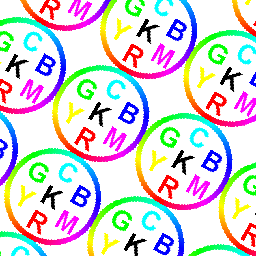 * Radial Gradient Shader
SkColor colors[2] = {SK_ColorBLUE, SK_ColorYELLOW};
SkPaint paint;
paint.setShader(SkGradientShader::MakeRadial(
SkPoint::Make(128.0f, 128.0f), 180.0f,
colors, nullptr, 2, SkShader::kClamp_TileMode, 0, nullptr));
canvas->drawPaint(paint);
* Radial Gradient Shader
SkColor colors[2] = {SK_ColorBLUE, SK_ColorYELLOW};
SkPaint paint;
paint.setShader(SkGradientShader::MakeRadial(
SkPoint::Make(128.0f, 128.0f), 180.0f,
colors, nullptr, 2, SkShader::kClamp_TileMode, 0, nullptr));
canvas->drawPaint(paint);
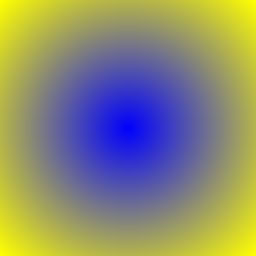 * Two-Point Conical Gradient Shader
SkColor colors[2] = {SK_ColorBLUE, SK_ColorYELLOW};
SkPaint paint;
paint.setShader(SkGradientShader::MakeTwoPointConical(
SkPoint::Make(128.0f, 128.0f), 128.0f,
SkPoint::Make(128.0f, 16.0f), 16.0f,
colors, nullptr, 2, SkShader::kClamp_TileMode, 0, nullptr));
canvas->drawPaint(paint);
* Two-Point Conical Gradient Shader
SkColor colors[2] = {SK_ColorBLUE, SK_ColorYELLOW};
SkPaint paint;
paint.setShader(SkGradientShader::MakeTwoPointConical(
SkPoint::Make(128.0f, 128.0f), 128.0f,
SkPoint::Make(128.0f, 16.0f), 16.0f,
colors, nullptr, 2, SkShader::kClamp_TileMode, 0, nullptr));
canvas->drawPaint(paint);
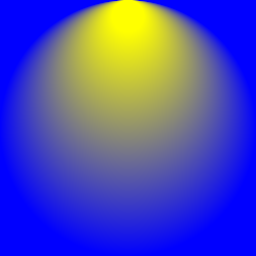 * Sweep Gradient Shader
SkColor colors[4] = {
SK_ColorCYAN, SK_ColorMAGENTA, SK_ColorYELLOW, SK_ColorCYAN};
SkPaint paint;
paint.setShader(SkGradientShader::MakeSweep(
128.0f, 128.0f, colors, nullptr, 4, 0, nullptr));
canvas->drawPaint(paint);
* Sweep Gradient Shader
SkColor colors[4] = {
SK_ColorCYAN, SK_ColorMAGENTA, SK_ColorYELLOW, SK_ColorCYAN};
SkPaint paint;
paint.setShader(SkGradientShader::MakeSweep(
128.0f, 128.0f, colors, nullptr, 4, 0, nullptr));
canvas->drawPaint(paint);
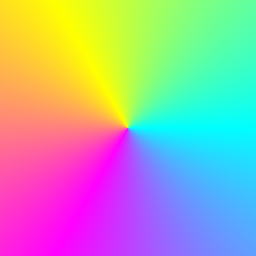 * Fractal Perlin Noise Shader
canvas->clear(SK_ColorWHITE);
SkPaint paint;
paint.setShader(SkPerlinNoiseShader::MakeFractalNoise(
0.05f, 0.05f, 4, 0.0f, nullptr));
canvas->drawPaint(paint);
* Fractal Perlin Noise Shader
canvas->clear(SK_ColorWHITE);
SkPaint paint;
paint.setShader(SkPerlinNoiseShader::MakeFractalNoise(
0.05f, 0.05f, 4, 0.0f, nullptr));
canvas->drawPaint(paint);
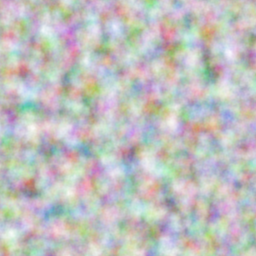 * Turbulence Perlin Noise Shader
canvas->clear(SK_ColorWHITE);
SkPaint paint;
paint.setShader(SkPerlinNoiseShader::MakeTurbulence(
0.05f, 0.05f, 4, 0.0f, nullptr));
canvas->drawPaint(paint);
* Turbulence Perlin Noise Shader
canvas->clear(SK_ColorWHITE);
SkPaint paint;
paint.setShader(SkPerlinNoiseShader::MakeTurbulence(
0.05f, 0.05f, 4, 0.0f, nullptr));
canvas->drawPaint(paint);
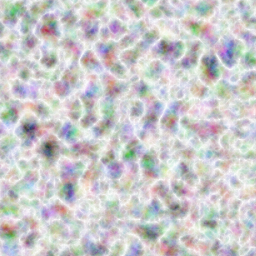 * Compose Shader
SkColor colors[2] = {SK_ColorBLUE, SK_ColorYELLOW};
SkPaint paint;
paint.setShader(
SkShader::MakeComposeShader(
SkGradientShader::MakeRadial(
SkPoint::Make(128.0f, 128.0f), 180.0f,
colors, nullptr, 2, SkShader::kClamp_TileMode, 0, nullptr),
SkPerlinNoiseShader::MakeTurbulence(0.025f, 0.025f, 2, 0.0f, nullptr),
SkXfermode::kDifference_Mode)
);
canvas->drawPaint(paint);
* Compose Shader
SkColor colors[2] = {SK_ColorBLUE, SK_ColorYELLOW};
SkPaint paint;
paint.setShader(
SkShader::MakeComposeShader(
SkGradientShader::MakeRadial(
SkPoint::Make(128.0f, 128.0f), 180.0f,
colors, nullptr, 2, SkShader::kClamp_TileMode, 0, nullptr),
SkPerlinNoiseShader::MakeTurbulence(0.025f, 0.025f, 2, 0.0f, nullptr),
SkXfermode::kDifference_Mode)
);
canvas->drawPaint(paint);
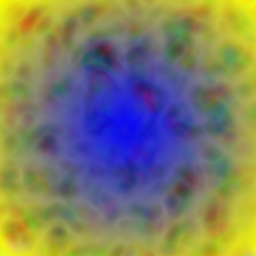 SkMaskFilter
------------
* Blur Mask Filter
canvas->drawText(text, strlen(text), 0, 160, paint);
canvas->drawColor(SK_ColorWHITE);
SkPaint paint;
paint.setAntiAlias(true);
paint.setTextSize(120);
paint.setMaskFilter(SkBlurMaskFilter::Make(
kNormal_SkBlurStyle, 5.0f, 0));
const char text[] = "Skia";
canvas->drawText(text, strlen(text), 0, 160, paint);
SkMaskFilter
------------
* Blur Mask Filter
canvas->drawText(text, strlen(text), 0, 160, paint);
canvas->drawColor(SK_ColorWHITE);
SkPaint paint;
paint.setAntiAlias(true);
paint.setTextSize(120);
paint.setMaskFilter(SkBlurMaskFilter::Make(
kNormal_SkBlurStyle, 5.0f, 0));
const char text[] = "Skia";
canvas->drawText(text, strlen(text), 0, 160, paint);
 * Emboss Mask Filter
canvas->drawColor(SK_ColorWHITE);
SkPaint paint;
paint.setAntiAlias(true);
paint.setTextSize(120);
SkScalar direction[3] = {1.0f, 1.0f, 1.0f};
paint.setMaskFilter(SkBlurMaskFilter::MakeEmboss(
2.0f, direction, 0.3f, 0.1f));
const char text[] = "Skia";
canvas->drawText(text, strlen(text), 0, 160, paint);
* Emboss Mask Filter
canvas->drawColor(SK_ColorWHITE);
SkPaint paint;
paint.setAntiAlias(true);
paint.setTextSize(120);
SkScalar direction[3] = {1.0f, 1.0f, 1.0f};
paint.setMaskFilter(SkBlurMaskFilter::MakeEmboss(
2.0f, direction, 0.3f, 0.1f));
const char text[] = "Skia";
canvas->drawText(text, strlen(text), 0, 160, paint);
 SkColorFilter
-------------
* Color Matrix Color Filter
void f(SkCanvas* c, SkScalar x, SkScalar y, SkScalar colorMatrix[20]) {
SkPaint paint;
paint.setColorFilter(SkColorFilter::MakeMatrixFilterRowMajor255(colorMatrix));
c->drawBitmap(source, x, y, &paint);
}
void draw(SkCanvas* c) {
c->scale(0.25, 0.25);
SkScalar colorMatrix1[20] = {
0, 1, 0, 0, 0,
0, 0, 1, 0, 0,
1, 0, 0, 0, 0,
0, 0, 0, 1, 0};
f(c, 0, 0, colorMatrix1);
SkScalar grayscale[20] = {
0.21, 0.72, 0.07, 0.0, 0.0,
0.21, 0.72, 0.07, 0.0, 0.0,
0.21, 0.72, 0.07, 0.0, 0.0,
0.0, 0.0, 0.0, 1.0, 0.0};
f(c, 512, 0, grayscale);
SkScalar colorMatrix3[20] = {
-1, 1, 1, 0, 0,
1, -1, 1, 0, 0,
1, 1, -1, 0, 0,
0, 0, 0, 1, 0};
f(c, 0, 512, colorMatrix3);
SkScalar colorMatrix4[20] = {
0.0, 0.5, 0.5, 0, 0,
0.5, 0.0, 0.5, 0, 0,
0.5, 0.5, 0.0, 0, 0,
0.0, 0.0, 0.0, 1, 0};
f(c, 512, 512, colorMatrix4);
SkScalar highContrast[20] = {
4.0, 0.0, 0.0, 0.0, -4.0 * 255 / (4.0 - 1),
0.0, 4.0, 0.0, 0.0, -4.0 * 255 / (4.0 - 1),
0.0, 0.0, 4.0, 0.0, -4.0 * 255 / (4.0 - 1),
0.0, 0.0, 0.0, 1.0, 0.0};
f(c, 1024, 0, highContrast);
SkScalar colorMatrix6[20] = {
0, 0, 1, 0, 0,
1, 0, 0, 0, 0,
0, 1, 0, 0, 0,
0, 0, 0, 1, 0};
f(c, 1024, 512, colorMatrix6);
SkScalar sepia[20] = {
0.393, 0.769, 0.189, 0.0, 0.0,
0.349, 0.686, 0.168, 0.0, 0.0,
0.272, 0.534, 0.131, 0.0, 0.0,
0.0, 0.0, 0.0, 1.0, 0.0};
f(c, 1536, 0, sepia);
SkScalar inverter[20] = {
-1, 0, 0, 0, 255,
0, -1, 0, 0, 255,
0, 0, -1, 0, 255,
0, 0, 0, 1, 0};
f(c, 1536, 512, inverter);
}
SkColorFilter
-------------
* Color Matrix Color Filter
void f(SkCanvas* c, SkScalar x, SkScalar y, SkScalar colorMatrix[20]) {
SkPaint paint;
paint.setColorFilter(SkColorFilter::MakeMatrixFilterRowMajor255(colorMatrix));
c->drawBitmap(source, x, y, &paint);
}
void draw(SkCanvas* c) {
c->scale(0.25, 0.25);
SkScalar colorMatrix1[20] = {
0, 1, 0, 0, 0,
0, 0, 1, 0, 0,
1, 0, 0, 0, 0,
0, 0, 0, 1, 0};
f(c, 0, 0, colorMatrix1);
SkScalar grayscale[20] = {
0.21, 0.72, 0.07, 0.0, 0.0,
0.21, 0.72, 0.07, 0.0, 0.0,
0.21, 0.72, 0.07, 0.0, 0.0,
0.0, 0.0, 0.0, 1.0, 0.0};
f(c, 512, 0, grayscale);
SkScalar colorMatrix3[20] = {
-1, 1, 1, 0, 0,
1, -1, 1, 0, 0,
1, 1, -1, 0, 0,
0, 0, 0, 1, 0};
f(c, 0, 512, colorMatrix3);
SkScalar colorMatrix4[20] = {
0.0, 0.5, 0.5, 0, 0,
0.5, 0.0, 0.5, 0, 0,
0.5, 0.5, 0.0, 0, 0,
0.0, 0.0, 0.0, 1, 0};
f(c, 512, 512, colorMatrix4);
SkScalar highContrast[20] = {
4.0, 0.0, 0.0, 0.0, -4.0 * 255 / (4.0 - 1),
0.0, 4.0, 0.0, 0.0, -4.0 * 255 / (4.0 - 1),
0.0, 0.0, 4.0, 0.0, -4.0 * 255 / (4.0 - 1),
0.0, 0.0, 0.0, 1.0, 0.0};
f(c, 1024, 0, highContrast);
SkScalar colorMatrix6[20] = {
0, 0, 1, 0, 0,
1, 0, 0, 0, 0,
0, 1, 0, 0, 0,
0, 0, 0, 1, 0};
f(c, 1024, 512, colorMatrix6);
SkScalar sepia[20] = {
0.393, 0.769, 0.189, 0.0, 0.0,
0.349, 0.686, 0.168, 0.0, 0.0,
0.272, 0.534, 0.131, 0.0, 0.0,
0.0, 0.0, 0.0, 1.0, 0.0};
f(c, 1536, 0, sepia);
SkScalar inverter[20] = {
-1, 0, 0, 0, 255,
0, -1, 0, 0, 255,
0, 0, -1, 0, 255,
0, 0, 0, 1, 0};
f(c, 1536, 512, inverter);
}
 * Color Table Color Filter
void draw(SkCanvas* canvas) {
canvas->scale(0.5, 0.5);
uint8_t ct[256];
for (int i = 0; i < 256; ++i) {
int x = (i - 96) * 255 / 64;
ct[i] = x < 0 ? 0 : x > 255 ? 255 : x;
}
SkPaint paint;
paint.setColorFilter(SkTableColorFilter::MakeARGB(nullptr, ct, ct, ct));
canvas->drawBitmap(source, 0, 0, &paint);
}
* Color Table Color Filter
void draw(SkCanvas* canvas) {
canvas->scale(0.5, 0.5);
uint8_t ct[256];
for (int i = 0; i < 256; ++i) {
int x = (i - 96) * 255 / 64;
ct[i] = x < 0 ? 0 : x > 255 ? 255 : x;
}
SkPaint paint;
paint.setColorFilter(SkTableColorFilter::MakeARGB(nullptr, ct, ct, ct));
canvas->drawBitmap(source, 0, 0, &paint);
}
 SkPathEffect
------------
* SkPath2DPathEffect: Stamp the specified path to fill the shape,
using the matrix to define the latice.
void draw(SkCanvas* canvas) {
SkScalar scale = 10.0f;
SkPath path;
static const int8_t pts[] = { 2, 2, 1, 3, 0, 3, 2, 1, 3, 1,
4, 0, 4, 1, 5, 1, 4, 2, 4, 3, 2, 5, 2, 4, 3, 3, 2, 3 };
path.moveTo(2 * scale, 3 * scale);
for (size_t i = 0 ; i < sizeof(pts)/sizeof(pts[0]); i += 2) {
path.lineTo(pts[i] * scale, pts[i + 1] * scale);
}
path.close();
SkMatrix matrix = SkMatrix::MakeScale(4 * scale);
SkPaint paint;
paint.setPathEffect(SkPath2DPathEffect::Make(matrix, path));
paint.setAntiAlias(true);
canvas->clear(SK_ColorWHITE);
SkRect bounds;
(void)canvas->getClipBounds(&bounds);
bounds.outset(2 * scale, 2 * scale);
canvas->drawRect(bounds, paint);
}
SkPathEffect
------------
* SkPath2DPathEffect: Stamp the specified path to fill the shape,
using the matrix to define the latice.
void draw(SkCanvas* canvas) {
SkScalar scale = 10.0f;
SkPath path;
static const int8_t pts[] = { 2, 2, 1, 3, 0, 3, 2, 1, 3, 1,
4, 0, 4, 1, 5, 1, 4, 2, 4, 3, 2, 5, 2, 4, 3, 3, 2, 3 };
path.moveTo(2 * scale, 3 * scale);
for (size_t i = 0 ; i < sizeof(pts)/sizeof(pts[0]); i += 2) {
path.lineTo(pts[i] * scale, pts[i + 1] * scale);
}
path.close();
SkMatrix matrix = SkMatrix::MakeScale(4 * scale);
SkPaint paint;
paint.setPathEffect(SkPath2DPathEffect::Make(matrix, path));
paint.setAntiAlias(true);
canvas->clear(SK_ColorWHITE);
SkRect bounds;
(void)canvas->getClipBounds(&bounds);
bounds.outset(2 * scale, 2 * scale);
canvas->drawRect(bounds, paint);
}
 * SkLine2DPathEffect: a special case of SkPath2DPathEffect where the
path is a straight line to be stroked, not a path to be filled.
void draw(SkCanvas* canvas) {
SkPaint paint;
SkMatrix lattice;
lattice.setScale(8.0f, 8.0f);
lattice.preRotate(30.0f);
paint.setPathEffect(SkLine2DPathEffect::Make(0.0f, lattice));
paint.setAntiAlias(true);
SkRect bounds;
(void)canvas->getClipBounds(&bounds);
bounds.outset(8.0f, 8.0f);
canvas->clear(SK_ColorWHITE);
canvas->drawRect(bounds, paint);
}
* SkLine2DPathEffect: a special case of SkPath2DPathEffect where the
path is a straight line to be stroked, not a path to be filled.
void draw(SkCanvas* canvas) {
SkPaint paint;
SkMatrix lattice;
lattice.setScale(8.0f, 8.0f);
lattice.preRotate(30.0f);
paint.setPathEffect(SkLine2DPathEffect::Make(0.0f, lattice));
paint.setAntiAlias(true);
SkRect bounds;
(void)canvas->getClipBounds(&bounds);
bounds.outset(8.0f, 8.0f);
canvas->clear(SK_ColorWHITE);
canvas->drawRect(bounds, paint);
}
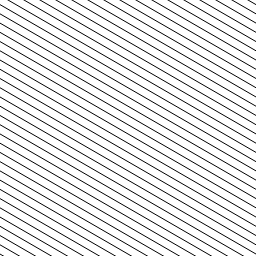 * SkPath1DPathEffect: create dash-like effects by replicating the specified path along the drawn path.
void draw(SkCanvas* canvas) {
SkPaint paint;
SkPath path;
path.addOval(SkRect::MakeWH(16.0f, 6.0f));
paint.setPathEffect(SkPath1DPathEffect::Make(
path, 32.0f, 0.0f, SkPath1DPathEffect::kRotate_Style));
paint.setAntiAlias(true);
canvas->clear(SK_ColorWHITE);
canvas->drawCircle(128.0f, 128.0f, 122.0f, paint);
}
* SkPath1DPathEffect: create dash-like effects by replicating the specified path along the drawn path.
void draw(SkCanvas* canvas) {
SkPaint paint;
SkPath path;
path.addOval(SkRect::MakeWH(16.0f, 6.0f));
paint.setPathEffect(SkPath1DPathEffect::Make(
path, 32.0f, 0.0f, SkPath1DPathEffect::kRotate_Style));
paint.setAntiAlias(true);
canvas->clear(SK_ColorWHITE);
canvas->drawCircle(128.0f, 128.0f, 122.0f, paint);
}
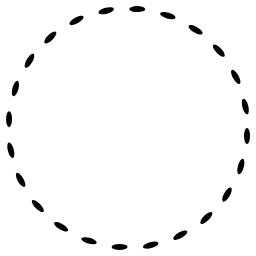 * SkArcToPathEffect
The following few examples use this function:
SkPath star() {
const SkScalar R = 115.2f, C = 128.0f;
SkPath path;
path.moveTo(C + R, C);
for (int i = 1; i < 8; ++i) {
SkScalar a = 2.6927937f * i;
path.lineTo(C + R * cos(a), C + R * sin(a));
}
return path;
}
void draw(SkCanvas* canvas) {
SkPaint paint;
paint.setPathEffect(SkArcToPathEffect::Make(8.0f));
paint.setStyle(SkPaint::kStroke_Style);
paint.setAntiAlias(true);
canvas->clear(SK_ColorWHITE);
SkPath path(star());
canvas->drawPath(path, paint);
}
* SkArcToPathEffect
The following few examples use this function:
SkPath star() {
const SkScalar R = 115.2f, C = 128.0f;
SkPath path;
path.moveTo(C + R, C);
for (int i = 1; i < 8; ++i) {
SkScalar a = 2.6927937f * i;
path.lineTo(C + R * cos(a), C + R * sin(a));
}
return path;
}
void draw(SkCanvas* canvas) {
SkPaint paint;
paint.setPathEffect(SkArcToPathEffect::Make(8.0f));
paint.setStyle(SkPaint::kStroke_Style);
paint.setAntiAlias(true);
canvas->clear(SK_ColorWHITE);
SkPath path(star());
canvas->drawPath(path, paint);
}
 * SkCornerPathEffect: a path effect that can turn sharp corners into
various treatments (e.g. rounded corners).
void draw(SkCanvas* canvas) {
SkPaint paint;
paint.setPathEffect(SkCornerPathEffect::Make(32.0f));
paint.setStyle(SkPaint::kStroke_Style);
paint.setAntiAlias(true);
canvas->clear(SK_ColorWHITE);
const SkScalar R = 115.2f;
SkPath path(star());
canvas->drawPath(path, paint);
}
* SkCornerPathEffect: a path effect that can turn sharp corners into
various treatments (e.g. rounded corners).
void draw(SkCanvas* canvas) {
SkPaint paint;
paint.setPathEffect(SkCornerPathEffect::Make(32.0f));
paint.setStyle(SkPaint::kStroke_Style);
paint.setAntiAlias(true);
canvas->clear(SK_ColorWHITE);
const SkScalar R = 115.2f;
SkPath path(star());
canvas->drawPath(path, paint);
}
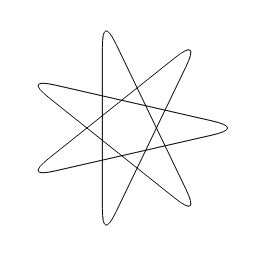 * SkDashPathEffect: a path effect that implements dashing.
void draw(SkCanvas* canvas) {
const SkScalar intervals[] = { 10.0f, 5.0f, 2.0f, 5.0f };
size_t count = sizeof(intervals) / sizeof(intervals[0]);
SkPaint paint;
paint.setPathEffect(SkDashPathEffect::Make(intervals, count, 0.0f));
paint.setStyle(SkPaint::kStroke_Style);
paint.setStrokeWidth(2.0f);
paint.setAntiAlias(true);
canvas->clear(SK_ColorWHITE);
SkPath path(star());
canvas->drawPath(path, paint);
}
* SkDashPathEffect: a path effect that implements dashing.
void draw(SkCanvas* canvas) {
const SkScalar intervals[] = { 10.0f, 5.0f, 2.0f, 5.0f };
size_t count = sizeof(intervals) / sizeof(intervals[0]);
SkPaint paint;
paint.setPathEffect(SkDashPathEffect::Make(intervals, count, 0.0f));
paint.setStyle(SkPaint::kStroke_Style);
paint.setStrokeWidth(2.0f);
paint.setAntiAlias(true);
canvas->clear(SK_ColorWHITE);
SkPath path(star());
canvas->drawPath(path, paint);
}
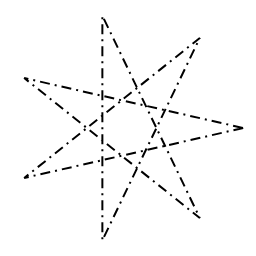 * SkDiscretePathEffect: This path effect chops a path into discrete
segments, and randomly displaces them.
void draw(SkCanvas* canvas) {
SkPaint paint;
paint.setPathEffect(SkDiscretePathEffect::Make(10.0f, 4.0f));
paint.setStyle(SkPaint::kStroke_Style);
paint.setStrokeWidth(2.0f);
paint.setAntiAlias(true);
canvas->clear(SK_ColorWHITE);
SkPath path(star());
canvas->drawPath(path, paint);
}
* SkDiscretePathEffect: This path effect chops a path into discrete
segments, and randomly displaces them.
void draw(SkCanvas* canvas) {
SkPaint paint;
paint.setPathEffect(SkDiscretePathEffect::Make(10.0f, 4.0f));
paint.setStyle(SkPaint::kStroke_Style);
paint.setStrokeWidth(2.0f);
paint.setAntiAlias(true);
canvas->clear(SK_ColorWHITE);
SkPath path(star());
canvas->drawPath(path, paint);
}
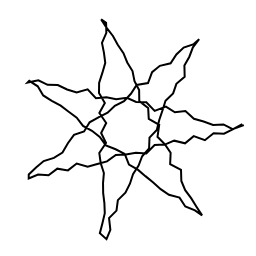 * SkComposePathEffect: a pathEffect whose effect is to apply
first the inner pathEffect and the the outer pathEffect (i.e.
outer(inner(path))).
void draw(SkCanvas* canvas) {
const SkScalar intervals[] = { 10.0f, 5.0f, 2.0f, 5.0f };
size_t count = sizeof(intervals) / sizeof(intervals[0]);
SkPaint paint;
paint.setPathEffect(SkComposePathEffect::Make(
SkDashPathEffect::Make(intervals, count, 0.0f),
SkDiscretePathEffect::Make(10.0f, 4.0f)
));
paint.setStyle(SkPaint::kStroke_Style);
paint.setStrokeWidth(2.0f);
paint.setAntiAlias(true);
canvas->clear(SK_ColorWHITE);
SkPath path(star());
canvas->drawPath(path, paint);
}
* SkComposePathEffect: a pathEffect whose effect is to apply
first the inner pathEffect and the the outer pathEffect (i.e.
outer(inner(path))).
void draw(SkCanvas* canvas) {
const SkScalar intervals[] = { 10.0f, 5.0f, 2.0f, 5.0f };
size_t count = sizeof(intervals) / sizeof(intervals[0]);
SkPaint paint;
paint.setPathEffect(SkComposePathEffect::Make(
SkDashPathEffect::Make(intervals, count, 0.0f),
SkDiscretePathEffect::Make(10.0f, 4.0f)
));
paint.setStyle(SkPaint::kStroke_Style);
paint.setStrokeWidth(2.0f);
paint.setAntiAlias(true);
canvas->clear(SK_ColorWHITE);
SkPath path(star());
canvas->drawPath(path, paint);
}
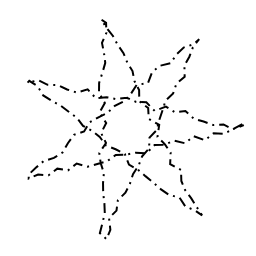 * SkSumPathEffect: a pathEffect whose effect is to apply two effects,
in sequence (i.e. first(path) + second(path)).
void draw(SkCanvas* canvas) {
SkPaint paint;
paint.setPathEffect(SkSumPathEffect::Make(
SkDiscretePathEffect::Make(10.0f, 4.0f),
SkDiscretePathEffect::Make(10.0f, 4.0f, 1245u)
));
paint.setStyle(SkPaint::kStroke_Style);
paint.setStrokeWidth(2.0f);
paint.setAntiAlias(true);
canvas->clear(SK_ColorWHITE);
SkPath path(star());
canvas->drawPath(path, paint);
}
* SkSumPathEffect: a pathEffect whose effect is to apply two effects,
in sequence (i.e. first(path) + second(path)).
void draw(SkCanvas* canvas) {
SkPaint paint;
paint.setPathEffect(SkSumPathEffect::Make(
SkDiscretePathEffect::Make(10.0f, 4.0f),
SkDiscretePathEffect::Make(10.0f, 4.0f, 1245u)
));
paint.setStyle(SkPaint::kStroke_Style);
paint.setStrokeWidth(2.0f);
paint.setAntiAlias(true);
canvas->clear(SK_ColorWHITE);
SkPath path(star());
canvas->drawPath(path, paint);
}
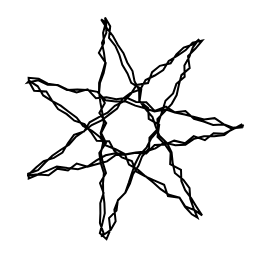
 This shows three different paints, each set up to draw in a different
style. Now the caller can intermix these paints freely, either using
them as is, or modifying them as the drawing proceeds.
SkPaint paint1, paint2, paint3;
paint2.setStyle(SkPaint::kStroke_Style);
paint2.setStrokeWidth(3);
paint3.setAntiAlias(true);
paint3.setColor(SK_ColorRED);
paint3.setTextSize(80);
canvas->drawRect(SkRect::MakeXYWH(10,10,60,20), paint1);
canvas->drawRect(SkRect::MakeXYWH(80,10,60,20), paint2);
paint2.setStrokeWidth(SkIntToScalar(5));
canvas->drawOval(SkRect::MakeXYWH(150,10,60,20), paint2);
canvas->drawText("SKIA", 4, 20, 120, paint3);
paint3.setColor(SK_ColorBLUE);
canvas->drawText("SKIA", 4, 20, 220, paint3);
This shows three different paints, each set up to draw in a different
style. Now the caller can intermix these paints freely, either using
them as is, or modifying them as the drawing proceeds.
SkPaint paint1, paint2, paint3;
paint2.setStyle(SkPaint::kStroke_Style);
paint2.setStrokeWidth(3);
paint3.setAntiAlias(true);
paint3.setColor(SK_ColorRED);
paint3.setTextSize(80);
canvas->drawRect(SkRect::MakeXYWH(10,10,60,20), paint1);
canvas->drawRect(SkRect::MakeXYWH(80,10,60,20), paint2);
paint2.setStrokeWidth(SkIntToScalar(5));
canvas->drawOval(SkRect::MakeXYWH(150,10,60,20), paint2);
canvas->drawText("SKIA", 4, 20, 120, paint3);
paint3.setColor(SK_ColorBLUE);
canvas->drawText("SKIA", 4, 20, 220, paint3);
 Beyond simple attributes such as color, strokes, and text values,
paints support effects. These are subclasses of different aspects of
the drawing pipeline, that when referenced by a paint (each of them is
reference-counted), are called to override some part of the drawing
pipeline.
For example, to draw using a gradient instead of a single color,
assign a SkShader to the paint.
void draw(SkCanvas* canvas) {
SkPoint points[2] = {
SkPoint::Make(0.0f, 0.0f),
SkPoint::Make(256.0f, 256.0f)
};
SkColor colors[2] = {SK_ColorBLUE, SK_ColorYELLOW};
SkPaint paint;
paint.setShader(SkGradientShader::MakeLinear(
points, colors, nullptr, 2,
SkShader::kClamp_TileMode, 0, nullptr));
canvas->drawPaint(paint);
}
Beyond simple attributes such as color, strokes, and text values,
paints support effects. These are subclasses of different aspects of
the drawing pipeline, that when referenced by a paint (each of them is
reference-counted), are called to override some part of the drawing
pipeline.
For example, to draw using a gradient instead of a single color,
assign a SkShader to the paint.
void draw(SkCanvas* canvas) {
SkPoint points[2] = {
SkPoint::Make(0.0f, 0.0f),
SkPoint::Make(256.0f, 256.0f)
};
SkColor colors[2] = {SK_ColorBLUE, SK_ColorYELLOW};
SkPaint paint;
paint.setShader(SkGradientShader::MakeLinear(
points, colors, nullptr, 2,
SkShader::kClamp_TileMode, 0, nullptr));
canvas->drawPaint(paint);
}
 Now, anything drawn with that paint will be drawn with the gradient
specified in the call to `MakeLinear()`. The shader object that is
returned is reference-counted. Whenever any effects object, like a
shader, is assigned to a paint, its reference-count is increased by
the paint. To balance this, the caller in the above example calls
`unref()` on the shader once it has assigned it to the paint. Now the
paint is the only "owner" of that shader, and it will automatically
call `unref()` on the shader when either the paint goes out of scope, or
if another shader (or null) is assigned to it.
There are 6 types of effects that can be assigned to a paint:
* **SkPathEffect** - modifications to the geometry (path) before it
generates an alpha mask (e.g. dashing)
* **SkRasterizer** - composing custom mask layers (e.g. shadows)
* **SkMaskFilter** - modifications to the alpha mask before it is
colorized and drawn (e.g. blur, emboss)
* **SkShader** - e.g. gradients (linear, radial, sweep), bitmap patterns
(clamp, repeat, mirror)
* **SkColorFilter** - modify the source color(s) before applying the
xfermode (e.g. color matrix)
* **SkXfermode** - e.g. porter-duff transfermodes, blend modes
Paints also hold a reference to a SkTypeface. The typeface represents
a specific font style, to be used for measuring and drawing
text. Speaking of which, paints are used not only for drawing text,
but also for measuring it.
paint.measureText(...);
paint.getTextBounds(...);
paint.textToGlyphs(...);
paint.getFontMetrics(...);
SkXfermode
----------
The following example demonstrates all of the Skia's standard transfer
modes. In this example the source is a solid magenta color with a
horizontal alpha gradient and the destination is a solid cyan color
with a vertical alpha gradient.
void draw(SkCanvas* canvas) {
SkXfermode::Mode modes[] = {
SkXfermode::kClear_Mode,
SkXfermode::kSrc_Mode,
SkXfermode::kDst_Mode,
SkXfermode::kSrcOver_Mode,
SkXfermode::kDstOver_Mode,
SkXfermode::kSrcIn_Mode,
SkXfermode::kDstIn_Mode,
SkXfermode::kSrcOut_Mode,
SkXfermode::kDstOut_Mode,
SkXfermode::kSrcATop_Mode,
SkXfermode::kDstATop_Mode,
SkXfermode::kXor_Mode,
SkXfermode::kPlus_Mode,
SkXfermode::kModulate_Mode,
SkXfermode::kScreen_Mode,
SkXfermode::kOverlay_Mode,
SkXfermode::kDarken_Mode,
SkXfermode::kLighten_Mode,
SkXfermode::kColorDodge_Mode,
SkXfermode::kColorBurn_Mode,
SkXfermode::kHardLight_Mode,
SkXfermode::kSoftLight_Mode,
SkXfermode::kDifference_Mode,
SkXfermode::kExclusion_Mode,
SkXfermode::kMultiply_Mode,
SkXfermode::kHue_Mode,
SkXfermode::kSaturation_Mode,
SkXfermode::kColor_Mode,
SkXfermode::kLuminosity_Mode,
};
SkRect rect = SkRect::MakeWH(64.0f, 64.0f);
SkPaint text, stroke, src, dst;
stroke.setStyle(SkPaint::kStroke_Style);
text.setTextSize(24.0f);
text.setAntiAlias(true);
SkPoint srcPoints[2] = {
SkPoint::Make(0.0f, 0.0f),
SkPoint::Make(64.0f, 0.0f)
};
SkColor srcColors[2] = {
SK_ColorMAGENTA & 0x00FFFFFF,
SK_ColorMAGENTA};
src.setShader(SkGradientShader::MakeLinear(
srcPoints, srcColors, nullptr, 2,
SkShader::kClamp_TileMode, 0, nullptr));
SkPoint dstPoints[2] = {
SkPoint::Make(0.0f, 0.0f),
SkPoint::Make(0.0f, 64.0f)
};
SkColor dstColors[2] = {
SK_ColorCYAN & 0x00FFFFFF,
SK_ColorCYAN};
dst.setShader(SkGradientShader::MakeLinear(
dstPoints, dstColors, nullptr, 2,
SkShader::kClamp_TileMode, 0, nullptr));
canvas->clear(SK_ColorWHITE);
size_t N = sizeof(modes) / sizeof(modes[0]);
size_t K = (N - 1) / 3 + 1;
SkASSERT(K * 64 == 640); // tall enough
for (size_t i = 0; i < N; ++i) {
SkAutoCanvasRestore autoCanvasRestore(canvas, true);
canvas->translate(192.0f * (i / K), 64.0f * (i % K));
const char* desc = SkXfermode::ModeName(modes[i]);
canvas->drawText(desc, strlen(desc), 68.0f, 30.0f, text);
canvas->clipRect(SkRect::MakeWH(64.0f, 64.0f));
canvas->drawColor(SK_ColorLTGRAY);
(void)canvas->saveLayer(nullptr, nullptr);
canvas->clear(SK_ColorTRANSPARENT);
canvas->drawPaint(dst);
src.setXfermodeMode(modes[i]);
canvas->drawPaint(src);
canvas->drawRect(rect, stroke);
}
}
Now, anything drawn with that paint will be drawn with the gradient
specified in the call to `MakeLinear()`. The shader object that is
returned is reference-counted. Whenever any effects object, like a
shader, is assigned to a paint, its reference-count is increased by
the paint. To balance this, the caller in the above example calls
`unref()` on the shader once it has assigned it to the paint. Now the
paint is the only "owner" of that shader, and it will automatically
call `unref()` on the shader when either the paint goes out of scope, or
if another shader (or null) is assigned to it.
There are 6 types of effects that can be assigned to a paint:
* **SkPathEffect** - modifications to the geometry (path) before it
generates an alpha mask (e.g. dashing)
* **SkRasterizer** - composing custom mask layers (e.g. shadows)
* **SkMaskFilter** - modifications to the alpha mask before it is
colorized and drawn (e.g. blur, emboss)
* **SkShader** - e.g. gradients (linear, radial, sweep), bitmap patterns
(clamp, repeat, mirror)
* **SkColorFilter** - modify the source color(s) before applying the
xfermode (e.g. color matrix)
* **SkXfermode** - e.g. porter-duff transfermodes, blend modes
Paints also hold a reference to a SkTypeface. The typeface represents
a specific font style, to be used for measuring and drawing
text. Speaking of which, paints are used not only for drawing text,
but also for measuring it.
paint.measureText(...);
paint.getTextBounds(...);
paint.textToGlyphs(...);
paint.getFontMetrics(...);
SkXfermode
----------
The following example demonstrates all of the Skia's standard transfer
modes. In this example the source is a solid magenta color with a
horizontal alpha gradient and the destination is a solid cyan color
with a vertical alpha gradient.
void draw(SkCanvas* canvas) {
SkXfermode::Mode modes[] = {
SkXfermode::kClear_Mode,
SkXfermode::kSrc_Mode,
SkXfermode::kDst_Mode,
SkXfermode::kSrcOver_Mode,
SkXfermode::kDstOver_Mode,
SkXfermode::kSrcIn_Mode,
SkXfermode::kDstIn_Mode,
SkXfermode::kSrcOut_Mode,
SkXfermode::kDstOut_Mode,
SkXfermode::kSrcATop_Mode,
SkXfermode::kDstATop_Mode,
SkXfermode::kXor_Mode,
SkXfermode::kPlus_Mode,
SkXfermode::kModulate_Mode,
SkXfermode::kScreen_Mode,
SkXfermode::kOverlay_Mode,
SkXfermode::kDarken_Mode,
SkXfermode::kLighten_Mode,
SkXfermode::kColorDodge_Mode,
SkXfermode::kColorBurn_Mode,
SkXfermode::kHardLight_Mode,
SkXfermode::kSoftLight_Mode,
SkXfermode::kDifference_Mode,
SkXfermode::kExclusion_Mode,
SkXfermode::kMultiply_Mode,
SkXfermode::kHue_Mode,
SkXfermode::kSaturation_Mode,
SkXfermode::kColor_Mode,
SkXfermode::kLuminosity_Mode,
};
SkRect rect = SkRect::MakeWH(64.0f, 64.0f);
SkPaint text, stroke, src, dst;
stroke.setStyle(SkPaint::kStroke_Style);
text.setTextSize(24.0f);
text.setAntiAlias(true);
SkPoint srcPoints[2] = {
SkPoint::Make(0.0f, 0.0f),
SkPoint::Make(64.0f, 0.0f)
};
SkColor srcColors[2] = {
SK_ColorMAGENTA & 0x00FFFFFF,
SK_ColorMAGENTA};
src.setShader(SkGradientShader::MakeLinear(
srcPoints, srcColors, nullptr, 2,
SkShader::kClamp_TileMode, 0, nullptr));
SkPoint dstPoints[2] = {
SkPoint::Make(0.0f, 0.0f),
SkPoint::Make(0.0f, 64.0f)
};
SkColor dstColors[2] = {
SK_ColorCYAN & 0x00FFFFFF,
SK_ColorCYAN};
dst.setShader(SkGradientShader::MakeLinear(
dstPoints, dstColors, nullptr, 2,
SkShader::kClamp_TileMode, 0, nullptr));
canvas->clear(SK_ColorWHITE);
size_t N = sizeof(modes) / sizeof(modes[0]);
size_t K = (N - 1) / 3 + 1;
SkASSERT(K * 64 == 640); // tall enough
for (size_t i = 0; i < N; ++i) {
SkAutoCanvasRestore autoCanvasRestore(canvas, true);
canvas->translate(192.0f * (i / K), 64.0f * (i % K));
const char* desc = SkXfermode::ModeName(modes[i]);
canvas->drawText(desc, strlen(desc), 68.0f, 30.0f, text);
canvas->clipRect(SkRect::MakeWH(64.0f, 64.0f));
canvas->drawColor(SK_ColorLTGRAY);
(void)canvas->saveLayer(nullptr, nullptr);
canvas->clear(SK_ColorTRANSPARENT);
canvas->drawPaint(dst);
src.setXfermodeMode(modes[i]);
canvas->drawPaint(src);
canvas->drawRect(rect, stroke);
}
}
 ShShader
--------
Several shaders are defined (besides the linear gradient already mentioned):
* Bitmap Shader
canvas->clear(SK_ColorWHITE);
SkMatrix matrix;
matrix.setScale(0.75f, 0.75f);
matrix.preRotate(30.0f);
SkPaint paint;
paint.setShader(SkShader::MakeBitmapShader(source,
SkShader::kRepeat_TileMode,
SkShader::kRepeat_TileMode,
&matrix));
canvas->drawPaint(paint);
ShShader
--------
Several shaders are defined (besides the linear gradient already mentioned):
* Bitmap Shader
canvas->clear(SK_ColorWHITE);
SkMatrix matrix;
matrix.setScale(0.75f, 0.75f);
matrix.preRotate(30.0f);
SkPaint paint;
paint.setShader(SkShader::MakeBitmapShader(source,
SkShader::kRepeat_TileMode,
SkShader::kRepeat_TileMode,
&matrix));
canvas->drawPaint(paint);
 * Radial Gradient Shader
SkColor colors[2] = {SK_ColorBLUE, SK_ColorYELLOW};
SkPaint paint;
paint.setShader(SkGradientShader::MakeRadial(
SkPoint::Make(128.0f, 128.0f), 180.0f,
colors, nullptr, 2, SkShader::kClamp_TileMode, 0, nullptr));
canvas->drawPaint(paint);
* Radial Gradient Shader
SkColor colors[2] = {SK_ColorBLUE, SK_ColorYELLOW};
SkPaint paint;
paint.setShader(SkGradientShader::MakeRadial(
SkPoint::Make(128.0f, 128.0f), 180.0f,
colors, nullptr, 2, SkShader::kClamp_TileMode, 0, nullptr));
canvas->drawPaint(paint);
 * Two-Point Conical Gradient Shader
SkColor colors[2] = {SK_ColorBLUE, SK_ColorYELLOW};
SkPaint paint;
paint.setShader(SkGradientShader::MakeTwoPointConical(
SkPoint::Make(128.0f, 128.0f), 128.0f,
SkPoint::Make(128.0f, 16.0f), 16.0f,
colors, nullptr, 2, SkShader::kClamp_TileMode, 0, nullptr));
canvas->drawPaint(paint);
* Two-Point Conical Gradient Shader
SkColor colors[2] = {SK_ColorBLUE, SK_ColorYELLOW};
SkPaint paint;
paint.setShader(SkGradientShader::MakeTwoPointConical(
SkPoint::Make(128.0f, 128.0f), 128.0f,
SkPoint::Make(128.0f, 16.0f), 16.0f,
colors, nullptr, 2, SkShader::kClamp_TileMode, 0, nullptr));
canvas->drawPaint(paint);
 * Sweep Gradient Shader
SkColor colors[4] = {
SK_ColorCYAN, SK_ColorMAGENTA, SK_ColorYELLOW, SK_ColorCYAN};
SkPaint paint;
paint.setShader(SkGradientShader::MakeSweep(
128.0f, 128.0f, colors, nullptr, 4, 0, nullptr));
canvas->drawPaint(paint);
* Sweep Gradient Shader
SkColor colors[4] = {
SK_ColorCYAN, SK_ColorMAGENTA, SK_ColorYELLOW, SK_ColorCYAN};
SkPaint paint;
paint.setShader(SkGradientShader::MakeSweep(
128.0f, 128.0f, colors, nullptr, 4, 0, nullptr));
canvas->drawPaint(paint);
 * Fractal Perlin Noise Shader
canvas->clear(SK_ColorWHITE);
SkPaint paint;
paint.setShader(SkPerlinNoiseShader::MakeFractalNoise(
0.05f, 0.05f, 4, 0.0f, nullptr));
canvas->drawPaint(paint);
* Fractal Perlin Noise Shader
canvas->clear(SK_ColorWHITE);
SkPaint paint;
paint.setShader(SkPerlinNoiseShader::MakeFractalNoise(
0.05f, 0.05f, 4, 0.0f, nullptr));
canvas->drawPaint(paint);
 * Turbulence Perlin Noise Shader
canvas->clear(SK_ColorWHITE);
SkPaint paint;
paint.setShader(SkPerlinNoiseShader::MakeTurbulence(
0.05f, 0.05f, 4, 0.0f, nullptr));
canvas->drawPaint(paint);
* Turbulence Perlin Noise Shader
canvas->clear(SK_ColorWHITE);
SkPaint paint;
paint.setShader(SkPerlinNoiseShader::MakeTurbulence(
0.05f, 0.05f, 4, 0.0f, nullptr));
canvas->drawPaint(paint);
 * Compose Shader
SkColor colors[2] = {SK_ColorBLUE, SK_ColorYELLOW};
SkPaint paint;
paint.setShader(
SkShader::MakeComposeShader(
SkGradientShader::MakeRadial(
SkPoint::Make(128.0f, 128.0f), 180.0f,
colors, nullptr, 2, SkShader::kClamp_TileMode, 0, nullptr),
SkPerlinNoiseShader::MakeTurbulence(0.025f, 0.025f, 2, 0.0f, nullptr),
SkXfermode::kDifference_Mode)
);
canvas->drawPaint(paint);
* Compose Shader
SkColor colors[2] = {SK_ColorBLUE, SK_ColorYELLOW};
SkPaint paint;
paint.setShader(
SkShader::MakeComposeShader(
SkGradientShader::MakeRadial(
SkPoint::Make(128.0f, 128.0f), 180.0f,
colors, nullptr, 2, SkShader::kClamp_TileMode, 0, nullptr),
SkPerlinNoiseShader::MakeTurbulence(0.025f, 0.025f, 2, 0.0f, nullptr),
SkXfermode::kDifference_Mode)
);
canvas->drawPaint(paint);
 SkMaskFilter
------------
* Blur Mask Filter
canvas->drawText(text, strlen(text), 0, 160, paint);
canvas->drawColor(SK_ColorWHITE);
SkPaint paint;
paint.setAntiAlias(true);
paint.setTextSize(120);
paint.setMaskFilter(SkBlurMaskFilter::Make(
kNormal_SkBlurStyle, 5.0f, 0));
const char text[] = "Skia";
canvas->drawText(text, strlen(text), 0, 160, paint);
SkMaskFilter
------------
* Blur Mask Filter
canvas->drawText(text, strlen(text), 0, 160, paint);
canvas->drawColor(SK_ColorWHITE);
SkPaint paint;
paint.setAntiAlias(true);
paint.setTextSize(120);
paint.setMaskFilter(SkBlurMaskFilter::Make(
kNormal_SkBlurStyle, 5.0f, 0));
const char text[] = "Skia";
canvas->drawText(text, strlen(text), 0, 160, paint);
 * Emboss Mask Filter
canvas->drawColor(SK_ColorWHITE);
SkPaint paint;
paint.setAntiAlias(true);
paint.setTextSize(120);
SkScalar direction[3] = {1.0f, 1.0f, 1.0f};
paint.setMaskFilter(SkBlurMaskFilter::MakeEmboss(
2.0f, direction, 0.3f, 0.1f));
const char text[] = "Skia";
canvas->drawText(text, strlen(text), 0, 160, paint);
* Emboss Mask Filter
canvas->drawColor(SK_ColorWHITE);
SkPaint paint;
paint.setAntiAlias(true);
paint.setTextSize(120);
SkScalar direction[3] = {1.0f, 1.0f, 1.0f};
paint.setMaskFilter(SkBlurMaskFilter::MakeEmboss(
2.0f, direction, 0.3f, 0.1f));
const char text[] = "Skia";
canvas->drawText(text, strlen(text), 0, 160, paint);
 SkColorFilter
-------------
* Color Matrix Color Filter
void f(SkCanvas* c, SkScalar x, SkScalar y, SkScalar colorMatrix[20]) {
SkPaint paint;
paint.setColorFilter(SkColorFilter::MakeMatrixFilterRowMajor255(colorMatrix));
c->drawBitmap(source, x, y, &paint);
}
void draw(SkCanvas* c) {
c->scale(0.25, 0.25);
SkScalar colorMatrix1[20] = {
0, 1, 0, 0, 0,
0, 0, 1, 0, 0,
1, 0, 0, 0, 0,
0, 0, 0, 1, 0};
f(c, 0, 0, colorMatrix1);
SkScalar grayscale[20] = {
0.21, 0.72, 0.07, 0.0, 0.0,
0.21, 0.72, 0.07, 0.0, 0.0,
0.21, 0.72, 0.07, 0.0, 0.0,
0.0, 0.0, 0.0, 1.0, 0.0};
f(c, 512, 0, grayscale);
SkScalar colorMatrix3[20] = {
-1, 1, 1, 0, 0,
1, -1, 1, 0, 0,
1, 1, -1, 0, 0,
0, 0, 0, 1, 0};
f(c, 0, 512, colorMatrix3);
SkScalar colorMatrix4[20] = {
0.0, 0.5, 0.5, 0, 0,
0.5, 0.0, 0.5, 0, 0,
0.5, 0.5, 0.0, 0, 0,
0.0, 0.0, 0.0, 1, 0};
f(c, 512, 512, colorMatrix4);
SkScalar highContrast[20] = {
4.0, 0.0, 0.0, 0.0, -4.0 * 255 / (4.0 - 1),
0.0, 4.0, 0.0, 0.0, -4.0 * 255 / (4.0 - 1),
0.0, 0.0, 4.0, 0.0, -4.0 * 255 / (4.0 - 1),
0.0, 0.0, 0.0, 1.0, 0.0};
f(c, 1024, 0, highContrast);
SkScalar colorMatrix6[20] = {
0, 0, 1, 0, 0,
1, 0, 0, 0, 0,
0, 1, 0, 0, 0,
0, 0, 0, 1, 0};
f(c, 1024, 512, colorMatrix6);
SkScalar sepia[20] = {
0.393, 0.769, 0.189, 0.0, 0.0,
0.349, 0.686, 0.168, 0.0, 0.0,
0.272, 0.534, 0.131, 0.0, 0.0,
0.0, 0.0, 0.0, 1.0, 0.0};
f(c, 1536, 0, sepia);
SkScalar inverter[20] = {
-1, 0, 0, 0, 255,
0, -1, 0, 0, 255,
0, 0, -1, 0, 255,
0, 0, 0, 1, 0};
f(c, 1536, 512, inverter);
}
SkColorFilter
-------------
* Color Matrix Color Filter
void f(SkCanvas* c, SkScalar x, SkScalar y, SkScalar colorMatrix[20]) {
SkPaint paint;
paint.setColorFilter(SkColorFilter::MakeMatrixFilterRowMajor255(colorMatrix));
c->drawBitmap(source, x, y, &paint);
}
void draw(SkCanvas* c) {
c->scale(0.25, 0.25);
SkScalar colorMatrix1[20] = {
0, 1, 0, 0, 0,
0, 0, 1, 0, 0,
1, 0, 0, 0, 0,
0, 0, 0, 1, 0};
f(c, 0, 0, colorMatrix1);
SkScalar grayscale[20] = {
0.21, 0.72, 0.07, 0.0, 0.0,
0.21, 0.72, 0.07, 0.0, 0.0,
0.21, 0.72, 0.07, 0.0, 0.0,
0.0, 0.0, 0.0, 1.0, 0.0};
f(c, 512, 0, grayscale);
SkScalar colorMatrix3[20] = {
-1, 1, 1, 0, 0,
1, -1, 1, 0, 0,
1, 1, -1, 0, 0,
0, 0, 0, 1, 0};
f(c, 0, 512, colorMatrix3);
SkScalar colorMatrix4[20] = {
0.0, 0.5, 0.5, 0, 0,
0.5, 0.0, 0.5, 0, 0,
0.5, 0.5, 0.0, 0, 0,
0.0, 0.0, 0.0, 1, 0};
f(c, 512, 512, colorMatrix4);
SkScalar highContrast[20] = {
4.0, 0.0, 0.0, 0.0, -4.0 * 255 / (4.0 - 1),
0.0, 4.0, 0.0, 0.0, -4.0 * 255 / (4.0 - 1),
0.0, 0.0, 4.0, 0.0, -4.0 * 255 / (4.0 - 1),
0.0, 0.0, 0.0, 1.0, 0.0};
f(c, 1024, 0, highContrast);
SkScalar colorMatrix6[20] = {
0, 0, 1, 0, 0,
1, 0, 0, 0, 0,
0, 1, 0, 0, 0,
0, 0, 0, 1, 0};
f(c, 1024, 512, colorMatrix6);
SkScalar sepia[20] = {
0.393, 0.769, 0.189, 0.0, 0.0,
0.349, 0.686, 0.168, 0.0, 0.0,
0.272, 0.534, 0.131, 0.0, 0.0,
0.0, 0.0, 0.0, 1.0, 0.0};
f(c, 1536, 0, sepia);
SkScalar inverter[20] = {
-1, 0, 0, 0, 255,
0, -1, 0, 0, 255,
0, 0, -1, 0, 255,
0, 0, 0, 1, 0};
f(c, 1536, 512, inverter);
}
 * Color Table Color Filter
void draw(SkCanvas* canvas) {
canvas->scale(0.5, 0.5);
uint8_t ct[256];
for (int i = 0; i < 256; ++i) {
int x = (i - 96) * 255 / 64;
ct[i] = x < 0 ? 0 : x > 255 ? 255 : x;
}
SkPaint paint;
paint.setColorFilter(SkTableColorFilter::MakeARGB(nullptr, ct, ct, ct));
canvas->drawBitmap(source, 0, 0, &paint);
}
* Color Table Color Filter
void draw(SkCanvas* canvas) {
canvas->scale(0.5, 0.5);
uint8_t ct[256];
for (int i = 0; i < 256; ++i) {
int x = (i - 96) * 255 / 64;
ct[i] = x < 0 ? 0 : x > 255 ? 255 : x;
}
SkPaint paint;
paint.setColorFilter(SkTableColorFilter::MakeARGB(nullptr, ct, ct, ct));
canvas->drawBitmap(source, 0, 0, &paint);
}
 SkPathEffect
------------
* SkPath2DPathEffect: Stamp the specified path to fill the shape,
using the matrix to define the latice.
void draw(SkCanvas* canvas) {
SkScalar scale = 10.0f;
SkPath path;
static const int8_t pts[] = { 2, 2, 1, 3, 0, 3, 2, 1, 3, 1,
4, 0, 4, 1, 5, 1, 4, 2, 4, 3, 2, 5, 2, 4, 3, 3, 2, 3 };
path.moveTo(2 * scale, 3 * scale);
for (size_t i = 0 ; i < sizeof(pts)/sizeof(pts[0]); i += 2) {
path.lineTo(pts[i] * scale, pts[i + 1] * scale);
}
path.close();
SkMatrix matrix = SkMatrix::MakeScale(4 * scale);
SkPaint paint;
paint.setPathEffect(SkPath2DPathEffect::Make(matrix, path));
paint.setAntiAlias(true);
canvas->clear(SK_ColorWHITE);
SkRect bounds;
(void)canvas->getClipBounds(&bounds);
bounds.outset(2 * scale, 2 * scale);
canvas->drawRect(bounds, paint);
}
SkPathEffect
------------
* SkPath2DPathEffect: Stamp the specified path to fill the shape,
using the matrix to define the latice.
void draw(SkCanvas* canvas) {
SkScalar scale = 10.0f;
SkPath path;
static const int8_t pts[] = { 2, 2, 1, 3, 0, 3, 2, 1, 3, 1,
4, 0, 4, 1, 5, 1, 4, 2, 4, 3, 2, 5, 2, 4, 3, 3, 2, 3 };
path.moveTo(2 * scale, 3 * scale);
for (size_t i = 0 ; i < sizeof(pts)/sizeof(pts[0]); i += 2) {
path.lineTo(pts[i] * scale, pts[i + 1] * scale);
}
path.close();
SkMatrix matrix = SkMatrix::MakeScale(4 * scale);
SkPaint paint;
paint.setPathEffect(SkPath2DPathEffect::Make(matrix, path));
paint.setAntiAlias(true);
canvas->clear(SK_ColorWHITE);
SkRect bounds;
(void)canvas->getClipBounds(&bounds);
bounds.outset(2 * scale, 2 * scale);
canvas->drawRect(bounds, paint);
}
 * SkLine2DPathEffect: a special case of SkPath2DPathEffect where the
path is a straight line to be stroked, not a path to be filled.
void draw(SkCanvas* canvas) {
SkPaint paint;
SkMatrix lattice;
lattice.setScale(8.0f, 8.0f);
lattice.preRotate(30.0f);
paint.setPathEffect(SkLine2DPathEffect::Make(0.0f, lattice));
paint.setAntiAlias(true);
SkRect bounds;
(void)canvas->getClipBounds(&bounds);
bounds.outset(8.0f, 8.0f);
canvas->clear(SK_ColorWHITE);
canvas->drawRect(bounds, paint);
}
* SkLine2DPathEffect: a special case of SkPath2DPathEffect where the
path is a straight line to be stroked, not a path to be filled.
void draw(SkCanvas* canvas) {
SkPaint paint;
SkMatrix lattice;
lattice.setScale(8.0f, 8.0f);
lattice.preRotate(30.0f);
paint.setPathEffect(SkLine2DPathEffect::Make(0.0f, lattice));
paint.setAntiAlias(true);
SkRect bounds;
(void)canvas->getClipBounds(&bounds);
bounds.outset(8.0f, 8.0f);
canvas->clear(SK_ColorWHITE);
canvas->drawRect(bounds, paint);
}
 * SkPath1DPathEffect: create dash-like effects by replicating the specified path along the drawn path.
void draw(SkCanvas* canvas) {
SkPaint paint;
SkPath path;
path.addOval(SkRect::MakeWH(16.0f, 6.0f));
paint.setPathEffect(SkPath1DPathEffect::Make(
path, 32.0f, 0.0f, SkPath1DPathEffect::kRotate_Style));
paint.setAntiAlias(true);
canvas->clear(SK_ColorWHITE);
canvas->drawCircle(128.0f, 128.0f, 122.0f, paint);
}
* SkPath1DPathEffect: create dash-like effects by replicating the specified path along the drawn path.
void draw(SkCanvas* canvas) {
SkPaint paint;
SkPath path;
path.addOval(SkRect::MakeWH(16.0f, 6.0f));
paint.setPathEffect(SkPath1DPathEffect::Make(
path, 32.0f, 0.0f, SkPath1DPathEffect::kRotate_Style));
paint.setAntiAlias(true);
canvas->clear(SK_ColorWHITE);
canvas->drawCircle(128.0f, 128.0f, 122.0f, paint);
}
 * SkArcToPathEffect
The following few examples use this function:
SkPath star() {
const SkScalar R = 115.2f, C = 128.0f;
SkPath path;
path.moveTo(C + R, C);
for (int i = 1; i < 8; ++i) {
SkScalar a = 2.6927937f * i;
path.lineTo(C + R * cos(a), C + R * sin(a));
}
return path;
}
void draw(SkCanvas* canvas) {
SkPaint paint;
paint.setPathEffect(SkArcToPathEffect::Make(8.0f));
paint.setStyle(SkPaint::kStroke_Style);
paint.setAntiAlias(true);
canvas->clear(SK_ColorWHITE);
SkPath path(star());
canvas->drawPath(path, paint);
}
* SkArcToPathEffect
The following few examples use this function:
SkPath star() {
const SkScalar R = 115.2f, C = 128.0f;
SkPath path;
path.moveTo(C + R, C);
for (int i = 1; i < 8; ++i) {
SkScalar a = 2.6927937f * i;
path.lineTo(C + R * cos(a), C + R * sin(a));
}
return path;
}
void draw(SkCanvas* canvas) {
SkPaint paint;
paint.setPathEffect(SkArcToPathEffect::Make(8.0f));
paint.setStyle(SkPaint::kStroke_Style);
paint.setAntiAlias(true);
canvas->clear(SK_ColorWHITE);
SkPath path(star());
canvas->drawPath(path, paint);
}
 * SkCornerPathEffect: a path effect that can turn sharp corners into
various treatments (e.g. rounded corners).
void draw(SkCanvas* canvas) {
SkPaint paint;
paint.setPathEffect(SkCornerPathEffect::Make(32.0f));
paint.setStyle(SkPaint::kStroke_Style);
paint.setAntiAlias(true);
canvas->clear(SK_ColorWHITE);
const SkScalar R = 115.2f;
SkPath path(star());
canvas->drawPath(path, paint);
}
* SkCornerPathEffect: a path effect that can turn sharp corners into
various treatments (e.g. rounded corners).
void draw(SkCanvas* canvas) {
SkPaint paint;
paint.setPathEffect(SkCornerPathEffect::Make(32.0f));
paint.setStyle(SkPaint::kStroke_Style);
paint.setAntiAlias(true);
canvas->clear(SK_ColorWHITE);
const SkScalar R = 115.2f;
SkPath path(star());
canvas->drawPath(path, paint);
}
 * SkDashPathEffect: a path effect that implements dashing.
void draw(SkCanvas* canvas) {
const SkScalar intervals[] = { 10.0f, 5.0f, 2.0f, 5.0f };
size_t count = sizeof(intervals) / sizeof(intervals[0]);
SkPaint paint;
paint.setPathEffect(SkDashPathEffect::Make(intervals, count, 0.0f));
paint.setStyle(SkPaint::kStroke_Style);
paint.setStrokeWidth(2.0f);
paint.setAntiAlias(true);
canvas->clear(SK_ColorWHITE);
SkPath path(star());
canvas->drawPath(path, paint);
}
* SkDashPathEffect: a path effect that implements dashing.
void draw(SkCanvas* canvas) {
const SkScalar intervals[] = { 10.0f, 5.0f, 2.0f, 5.0f };
size_t count = sizeof(intervals) / sizeof(intervals[0]);
SkPaint paint;
paint.setPathEffect(SkDashPathEffect::Make(intervals, count, 0.0f));
paint.setStyle(SkPaint::kStroke_Style);
paint.setStrokeWidth(2.0f);
paint.setAntiAlias(true);
canvas->clear(SK_ColorWHITE);
SkPath path(star());
canvas->drawPath(path, paint);
}
 * SkDiscretePathEffect: This path effect chops a path into discrete
segments, and randomly displaces them.
void draw(SkCanvas* canvas) {
SkPaint paint;
paint.setPathEffect(SkDiscretePathEffect::Make(10.0f, 4.0f));
paint.setStyle(SkPaint::kStroke_Style);
paint.setStrokeWidth(2.0f);
paint.setAntiAlias(true);
canvas->clear(SK_ColorWHITE);
SkPath path(star());
canvas->drawPath(path, paint);
}
* SkDiscretePathEffect: This path effect chops a path into discrete
segments, and randomly displaces them.
void draw(SkCanvas* canvas) {
SkPaint paint;
paint.setPathEffect(SkDiscretePathEffect::Make(10.0f, 4.0f));
paint.setStyle(SkPaint::kStroke_Style);
paint.setStrokeWidth(2.0f);
paint.setAntiAlias(true);
canvas->clear(SK_ColorWHITE);
SkPath path(star());
canvas->drawPath(path, paint);
}
 * SkComposePathEffect: a pathEffect whose effect is to apply
first the inner pathEffect and the the outer pathEffect (i.e.
outer(inner(path))).
void draw(SkCanvas* canvas) {
const SkScalar intervals[] = { 10.0f, 5.0f, 2.0f, 5.0f };
size_t count = sizeof(intervals) / sizeof(intervals[0]);
SkPaint paint;
paint.setPathEffect(SkComposePathEffect::Make(
SkDashPathEffect::Make(intervals, count, 0.0f),
SkDiscretePathEffect::Make(10.0f, 4.0f)
));
paint.setStyle(SkPaint::kStroke_Style);
paint.setStrokeWidth(2.0f);
paint.setAntiAlias(true);
canvas->clear(SK_ColorWHITE);
SkPath path(star());
canvas->drawPath(path, paint);
}
* SkComposePathEffect: a pathEffect whose effect is to apply
first the inner pathEffect and the the outer pathEffect (i.e.
outer(inner(path))).
void draw(SkCanvas* canvas) {
const SkScalar intervals[] = { 10.0f, 5.0f, 2.0f, 5.0f };
size_t count = sizeof(intervals) / sizeof(intervals[0]);
SkPaint paint;
paint.setPathEffect(SkComposePathEffect::Make(
SkDashPathEffect::Make(intervals, count, 0.0f),
SkDiscretePathEffect::Make(10.0f, 4.0f)
));
paint.setStyle(SkPaint::kStroke_Style);
paint.setStrokeWidth(2.0f);
paint.setAntiAlias(true);
canvas->clear(SK_ColorWHITE);
SkPath path(star());
canvas->drawPath(path, paint);
}
 * SkSumPathEffect: a pathEffect whose effect is to apply two effects,
in sequence (i.e. first(path) + second(path)).
void draw(SkCanvas* canvas) {
SkPaint paint;
paint.setPathEffect(SkSumPathEffect::Make(
SkDiscretePathEffect::Make(10.0f, 4.0f),
SkDiscretePathEffect::Make(10.0f, 4.0f, 1245u)
));
paint.setStyle(SkPaint::kStroke_Style);
paint.setStrokeWidth(2.0f);
paint.setAntiAlias(true);
canvas->clear(SK_ColorWHITE);
SkPath path(star());
canvas->drawPath(path, paint);
}
* SkSumPathEffect: a pathEffect whose effect is to apply two effects,
in sequence (i.e. first(path) + second(path)).
void draw(SkCanvas* canvas) {
SkPaint paint;
paint.setPathEffect(SkSumPathEffect::Make(
SkDiscretePathEffect::Make(10.0f, 4.0f),
SkDiscretePathEffect::Make(10.0f, 4.0f, 1245u)
));
paint.setStyle(SkPaint::kStroke_Style);
paint.setStrokeWidth(2.0f);
paint.setAntiAlias(true);
canvas->clear(SK_ColorWHITE);
SkPath path(star());
canvas->drawPath(path, paint);
}
